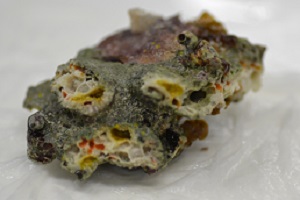Movement
Although the sponge itself does not move, sponge cells constantly move within the body. As this type of Cliona sp. is an encrusting as well as boring sponge, lateral movement occurs as it overgrows its host substrate.
Due to their strong space competing behaviour, these sponges cover a large portion of coral reefs significantly increasing over corals, becoming an epidemic (Lopez-Victoria and Zea 2005, Schonberg 2002).
Cliona is able to bore into a wide variety of substrates generally with no particular preference (i.e. they’re not substrate specific). However, if given the choice, some Cliona spp. have the capability to differentiate between various substrates, such as coral skeletons and calcareous rock, beginning to bore into the substrate which is most suitable (Calcinai et al. 2007; Holmes et al. 2009; Lopez-Victoria and Zea 2005; Schonberg 2002).
Several studies have been conducted on the preferential discrimination of substrates amongst C. aprica and C. caribbaea (Lopez-Victoria and Zea 2005; Schonberg 2003). According to Lopez-Victoria and Zea (2005), there was a preference towards particular coral substrates in which C. aprica preferred coral skeletons and C. caribbaea preferred calcareous rock. This discrimination may be as a result of substrate suitability for larvae settlement rather than lateral expansion. As calcareous rock is a common host for a range of invertebrate life, this prevents the sponge from undergoing lateral expansion and overtaking the rock as there is little space to spread. Although there may be individual preferences, the sponges are not restricted in their substrate choice (Schonberg 2003).
To what extent the sponge can spread, depends on the surface area, nature and architectural obstacles of the chosen substrate (Lopez-Victoria and Zea 2005). Calcareous rock appears to be more difficult for Cliona to grow into as opposed to coral skeleton as calcareous rock, especially older ones, are usually heavily encrusted with other organisms. Therefore, it appears that its ability to settle, survive and persist on a particular substrate, is due to the amount of uncovered substrate available. If the substrate it too covered, the sponge will begin to burrow downwards to make space for more tissue (Holmes et al. 2009).
Depth penetration generally does not exceed 2 cm (Lopez-Victoria and Zea 2005). This is seems to be as a result of the symbiotic relationship with photosynthetic zooxanthellae, therefore favouring lateral spread rather than depth penetration. Various approaches are taken by the sponge for directional movement (laterally and vertically). Lateral movement of the sponge occurs first once the sponge larva has settled. Once all available space has been overtaken by the sponge, depth penetration occurs.
Other than symbiotic relationship with zooxanthellae, other factors inhibiting depth penetration includes oxygen and nutrient availability. Recent studies suggest that as the sponge further enters the substrate, this may restrict oxygen and nutrient transport of tissues that are not surrounded by water (Calcinai et al. 2007, Schonberg 2002). Also in order to burrow at great depths in denser substrates, a sponge has to exert more energy, thus is metabolically expensive, all the more reason to prefer outward growth.
  Lateral spread (left) compared to vertical burrowing (right)
Lateral spread (left) compared to vertical burrowing (right) |